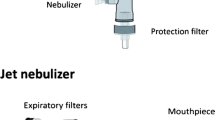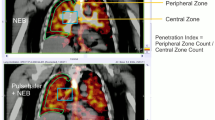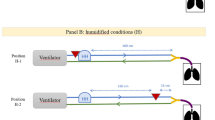Abstract
Purpose
This study aimed to evaluate the performance of a therapeutic vibrating mesh-type nebulizer for the pulmonary delivery of radioaerosols for lung scintigraphy in healthy subjects.
Methods
Six healthy subjects (mean age of 28.7 ± 6.2 years) inhaled 2 mL Tc-99m diethylenetriaminepentaacetic acid and normal saline solution (20 mCi) via a therapeutic vibrating mesh-type nebulizer (DK010, DELBio, Taipei, Taiwan). The nebulizer’s mass median aerodynamic diameter was between 2.3 and 5.0 µm (3.47 ± 0.37 µm), and the nebulization rate was greater than 0.2 mL/min. Scintigraphy was performed to count radioaerosols in the regions of interest to determine the total and regional lung deposition and extrathoracic airway deposition of aerosols, penetration of aerosols, and radioactivity count balance (RCB).
Results
The total lung depositions of aerosols were 21.2% ± 5.2% (% ex-valve dose), 27.4% ± 8.0% (% ex-device dose), and 13.8% ± 4.1% (% initial dose) in the nebulizer. The extrathoracic airway deposition was 4.8% ± 1.1%. The RCB was 5.4% ± 3.0%. The ratio of outer over inner lung deposition (O/I ratio, or penetration index) was 1.89 ± 0.55.
Conclusion
The delivery efficiency and penetration of aerosols to the peripheral lung, which were achieved by the DELBio DK010 vibrating mesh-type nebulizer, were similar to the commercialized jet-type nebulizers dedicated for radioaerosol lung scintigraphy nebulizer. The therapeutic vibrating mesh-type nebulizer (DELBio DK010) is feasible for radionuclide lung ventilation scintigraphy.



Similar content being viewed by others
References
Cohen, S. P., & Dawson, T. C. (2002). Nebulized morphine as a treatment for dyspnea in a child with cystic fibrosis. Pediatrics, 110(3), e38.
Kleinstreuer, C., Zhang, Z., & Donohue, J. F. (2008). Targeted drug-aerosol delivery in the human respiratory system. Annual Review of Biomedical Engineering, 10, 195–220.
Scheuch, G., & Siekmeier, R. (2007). Novel approaches to enhance pulmonary delivery of proteins and peptides. Journal of Physiology and Pharmacology, 58(Suppl 5, Pt 2), 615–625.
Hagerman, J. K., Hancock, K. E., & Klepser, M. E. (2006). Aerosolised antibiotics: A critical appraisal of their use. Expert Opinion in Drug Delivery, 3(1), 71–86.
Muers, M. F. (1997). Overview of nebuliser treatment. Thorax, 52(Suppl 2), S25-30.
Galindo-Filho, V. C., Ramos, M. E., Rattes, C. S., Barbosa, A. K., Brandao, D. C., Brandao, S. C., Fink, J. B., & de Andrade, A. D. (2015). Radioaerosol pulmonary deposition using mesh and jet nebulizers during noninvasive ventilation in healthy subjects. Respiratory Care, 60(9), 1238–1246.
Corcoran, T. E. (2015). Imaging in aerosol medicine. Respiratory Care, 60(6), 850–855; discussion 855–857.
Bhatnagar, A., Sawroop, K., Chopra, M. K., Kumar, N., Jaimini, A., & Bhatnagar, A. (2008). Ventilation scintigraphy with lipophilic cationic compounds. Nuclear Medicine Communications, 29(11), 987–993.
Isawa, T. (1998). Mucociliary scan. In Y. W. Bahk & K. E. Isawa (Eds.), Nuclear imaging of the chest (pp. 36–39). Springer.
Diot, P., & Lemarie, E (1993). Physiopathological bases. In Nuclear medicine and lung diseases (pp. 13–21). Springer.
Coates, A. L., Green, M., Leung, K., Louca, E., Tservistas, M., Chan, J., Ribeiro, N., & Charron, M. (2007). The challenges of quantitative measurement of lung deposition using 99mTc-DTPA from delivery systems with very different delivery times. Journal of Aerosol Medicine, 20(3), 320–330.
O’Callaghan, C., & Barry, P. W. (1997). The science of nebulised drug delivery. Thorax, 52(Suppl 2), S31-44.
Smart, J. R. (2002). A brief overview of novel liquid-based inhalation technologies. Drug Delivery Systems Science, 2, 67–71.
Dhand, R. (2002). Nebulizers that use a vibrating mesh or plate with multiple apertures to generate aerosol. Respiratory Care, 47(12), 1406–1416; discussion 1408–1416.
Abdelrahim, M. E., Plant, P., & Chrystyn, H. (2010). In vitro characterisation of the nebulised dose during non-invasive ventilation. Journal of Pharmacy and Pharmacology, 62(8), 966–972.
Dubus, J. C., Vecellio, L., De Monte, M., Fink, J. B., Grimbert, D., Montharu, J., Valat, C., Behan, N., & Diot, P. (2005). Aerosol deposition in neonatal ventilation. Pediatric Research, 58(1), 10–14.
Galindo-Filho, V. C., Brandao, D. C., Ferreira Rde, C., Menezes, M. J., Almeida-Filho, P., Parreira, V. F., Silva, T. N., Rodrigues-Machado Mda, G., Dean, E., & Dornelas de Andrade, A. (2013). Noninvasive ventilation coupled with nebulization during asthma crises: A randomized controlled trial. Respiratory Care, 58(2), 241–249.
Franca, E. E., Dornelas de Andrade, A. F., Cabral, G., Almeida Filho, P., Silva, K. C., Galindo Filho, V. C., Marinho, P. E., Lemos, A., & Parreira, V. F. (2006). Nebulization associated with bi-level noninvasive ventilation: Analysis of pulmonary radioaerosol deposition. Respiratory Medicine, 100(4), 721–728.
Dugernier, J., Hesse, M., Vanbever, R., Depoortere, V., Roeseler, J., Michotte, J. B., Laterre, P. F., Jamar, F., & Reychler, G. (2017). SPECT–CT comparison of lung deposition using a system combining a vibrating-mesh nebulizer with a valved holding chamber and a conventional jet nebulizer: A randomized cross-over study. Pharmaceutical Research, 34(2), 290–300.
Zeman, K. L., Wu, J., & Bennett, W. D. (2010). Targeting aerosolized drugs to the conducting airways using very large particles and extremely slow inhalations. Journal of Aerosol Medicine and Pulmonary Drug Delivery, 23(6), 363–369.
Bendstrup, K. E., Chambers, C. B., Jensen, J. I., & Newhouse, M. T. (1999). Lung deposition and clearance of inhaled (99m)Tc-heparin in healthy volunteers. American Journal of Respiratory and Critical Care Medicine, 160(5 Pt 1), 1653–1658.
Pitcairn, G. R., Lankinen, T., Seppala, O. P., & Newman, S. P. (2000). Pulmonary drug delivery from the Taifun dry powder inhaler is relatively independent of the patient’s inspiratory effort. Journal of Aerosol Medicine, 13(2), 97–104.
Hirst, P. H., Pitcairn, G. R., Weers, J. G., Tarara, T. E., Clark, A. R., Dellamary, L. A., Hall, G., Shorr, J., & Newman, S. P. (2002). In vivo lung deposition of hollow porous particles from a pressurized metered dose inhaler. Pharmaceutical Research, 19(3), 258–264.
Newman, S., Bennett, W. D., Biddiscombe, M., Devadason, S. G., Dolovich, M. B., Fleming, J., Haeussermann, S., Kietzig, C., Kuehl, P. J., Laube, B. L., et al. (2012). Standardization of techniques for using planar (2D) imaging for aerosol deposition assessment of orally inhaled products. Journal of Aerosol Medicine and Pulmonary Drug Delivery, 25(Suppl 1), S10-28.
Sorenson, J. A., & Phelps, D. (1980). Problems in radiation detection and measurement. In Physics in nuclear medicine (pp. 208–228). Grune and Gratton, Inc.
Laube, B. L. (1996). In vivo measurements of aerosol dose and distribution: Clinical relevance. Journal of Aerosol Medicine, 9(Suppl 1), S77-91.
Bennett, W. D., Xie, M., Zeman, K., Hurd, H., & Donaldson, S. (2015). Heterogeneity of particle deposition by pixel analysis of 2D gamma scintigraphy images. Journal of Aerosol Medicine and Pulmonary Drug Delivery, 28(3), 211–218.
Author information
Authors and Affiliations
Corresponding author
Ethics declarations
Conflict of interest
The authors have declared that no conflict of interest exists.
Rights and permissions
Springer Nature or its licensor (e.g. a society or other partner) holds exclusive rights to this article under a publishing agreement with the author(s) or other rightsholder(s); author self-archiving of the accepted manuscript version of this article is solely governed by the terms of such publishing agreement and applicable law.
About this article
Cite this article
Chang, CY., Yang, BH., Ke, CC. et al. Performance and Feasibility of Therapeutic Vibrating Mesh Nebulizer for Ventilation Lung Scan. J. Med. Biol. Eng. 42, 839–844 (2022). https://doi.org/10.1007/s40846-022-00757-w
Received:
Accepted:
Published:
Issue Date:
DOI: https://doi.org/10.1007/s40846-022-00757-w




